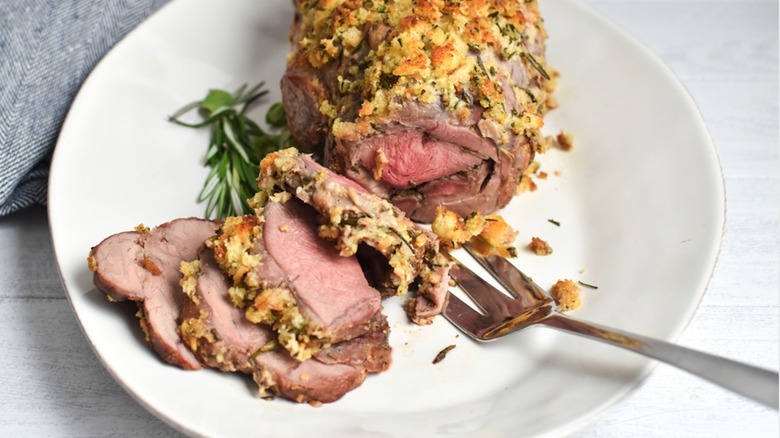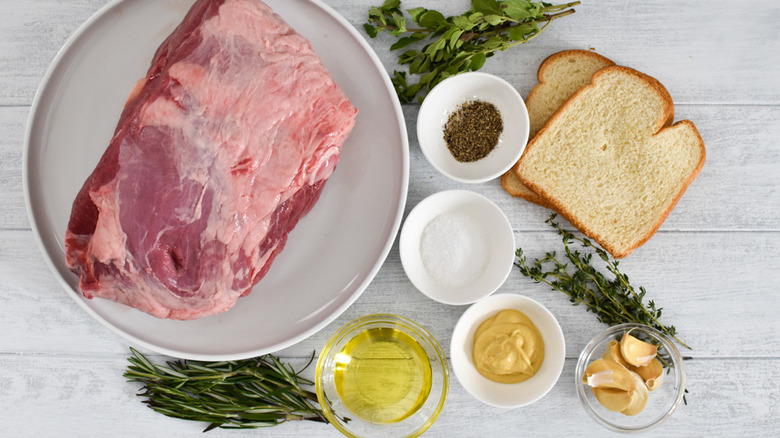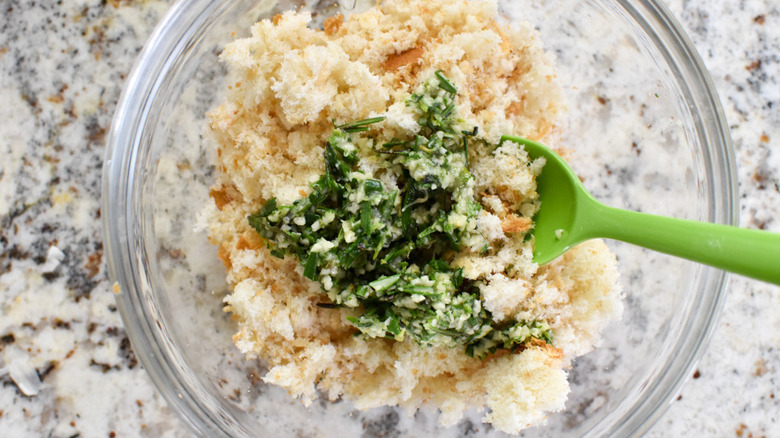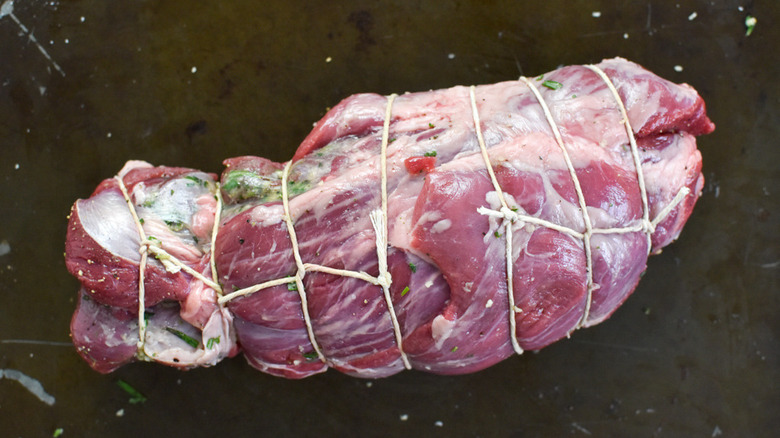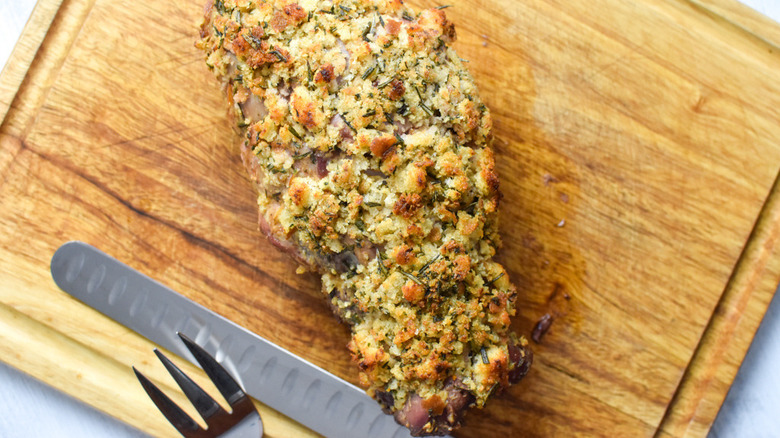Roast Leg Of Lamb Recipe
Let's be honest here: This roast leg of lamb recipe is neither the fastest nor easiest recipe you're going to find out there. Preparing a roast leg of lamb properly takes a good half an hour. Cooking it takes a full hour, and it's not an entirely hands-off process even once the meat is in the oven. But this entree will delight and, frankly, impress those assembled at your table so much that it's well worth the effort. Oh, and you'll rave over the rich, decadent flavors, too.
If you go step-by-step, closely following the directions laid out here by chef and recipe developer Stephanie Rapone, you'll be able to handle things. Make sure you trim the fat and hammer the lamb evenly, make sure you apply herbs, oil, and bread pieces lavishly, and keep a close watch on the meat as it cooks. And, when you slice into that perfectly tender, rich, and savory roast after nearly two hours in the kitchen, you'll be glad you put in the work. Looking to fill out the meal? Rapone says that "this would be delicious with some baby potatoes that have been roasted with salt, olive oil, and fresh rosemary."
Gather your ingredients to make roast leg of lamb
First and foremost, to make a roast large enough for about 10 servings, you'll need a boneless leg of lamb that weighs about four pounds. Then gather a couple of slices of sandwich bread, plenty of olive oil, several sprigs of fresh rosemary, fresh thyme, fresh oregano, about a half dozen garlic cloves, sea salt, fresh ground black pepper, and some Dijon mustard. A quick note about the lamb itself from Rapone: "Look for a leg of lamb that is already boneless. If you can't get a boneless piece, and you're not comfortable with deboning, then ask the butcher to do this process for you."
Make the breadcrumb and herb mixture
Move the oven rack to the second-lowest position, then preheat the oven to 375 F. While the oven is heating, start to prepare the herbs, seasonings and the breading for the lamb. Tear the bread into big chunks and put them in a food processor, then pulse it until you have large crumbs (about 10 pulses) and remove the bread to a medium bowl.
Rinse the herbs and pick the leaves off the stems, and add them to the food processor. Then, coarsely chop the garlic and add it as well. Now add a tablespoon of olive oil and a teaspoon of kosher salt. Pulse the food processor until everything is finely minced. Put two tablespoons of the herb mixture in a separate small bowl, then add the remaining herb mixture to the breadcrumbs. Add another three tablespoons of olive oil and stir to combine it with the bread.
Prepare the lamb
Place a piece of plastic wrap over a cutting board or large baking sheet, then lay the roast on the plastic wrap with the interior side facing up. Trim any large chunks of fat away, then cover the meat with another layer of plastic wrap. Use a meat tenderizer to pound the lamb out to a sheet that's one inch in thickness.
Remove the plastic, then season the interior side with a teaspoon of kosher salt and ½ teaspoon of pepper. Rub the herb mixture all over the lamb, then roll the roast and tie it with butchers twine, roughly every two inches across the roast. "The most challenging part is rolling and tying the lamb," Rapone says. "Just don't worry about it being perfect and it will turn out great!" Place a wire rack in a rimmed baking sheet and move the roast to the rack. Season the outside with the remaining teaspoon of kosher salt and the remaining ½ teaspoon of black pepper. Now, brush the Dijon all over the outside of the roast, then pack the breadcrumb mixture all over the top and sides, pressing it onto the roast so it sticks.
Roast the lamb, then enjoy
If you have a probe thermometer with a remote display, insert it into the middle of the roast and set the temperature for 130 F. Place the roast in the oven, then add ⅓ cup ofwater to the bottom pan — this will just help prevent any bread crumb mixture that falls off from burning.
Check the lamb after about 30 minutes of roasting. If the crumb coating is already golden, lightly tent the roast with foil to prevent the coating from burning. Roast the lamb for 60 minutes overall, and check the internal temperature with a probe meat thermometer a couple of times. You want to take the lamb out of the oven when it reaches 130 F.
Now let the lamb rest 20 minutes before carving, then carefully remove the strings (taking care not to knock off all the bread crumb mixture), slice the meat into half-inch thick slices, and serve.
Got extra? Rapone says: "I store it in an air-tight container in the fridge for up to five days. For re-serving, you can just microwave it to bring the temperature up, or my favorite is to make a panini with the leftover meat and provolone on sourdough."
Roast Leg Of Lamb Recipe
This roast leg of lamb recipe will delight and, frankly, impress those assembled at your table so much that it's well worth the effort.
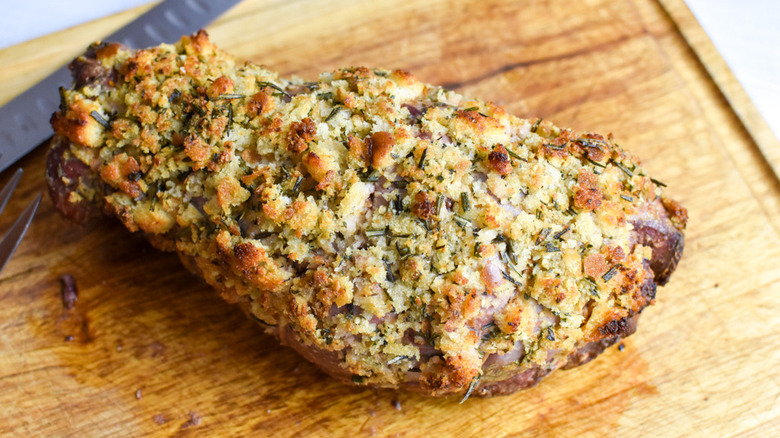
Ingredients
- 2 slices white bread
- 4 tablespoons olive oil, divided
- 4 sprigs fresh rosemary
- 4 sprigs fresh thyme
- 4 sprigs fresh oregano
- 6 garlic cloves
- 1 tablespoon sea salt, divided
- 1 teaspoon fresh ground black pepper, divided
- 4 pounds boneless leg of lamb
- 2 tablespoons Dijon mustard
Directions
- Move oven rack to the second-lowest position and preheat the oven to 375 F.
- Tear the bread into big chunks and put them in a food processor. Pulse until you have large crumbs, about 10 pulses, then put them into a medium bowl.
- Rinse the herbs, pick the leaves off the stems, and add them to the food processor. Coarsely chop the garlic and add it in as well. Add 1 tablespoon olive oil and 1 teaspoon salt. Pulse until everything is finely minced.
- Put 2 tablespoons of the herb mixture in a separate small bowl.
- Add the remaining herb mixture to the breadcrumbs, then add another 3 tablespoons of olive oil and stir to combine.
- Place a piece of plastic wrap over a cutting board or large baking sheet. Lay the roast on the plastic wrap with the interior side facing up. Trim any large chunks of fat. Cover with layer of plastic wrap. Use a meat tenderizer to pound out to 1" thickness.
- Season the interior side with 1 teaspoon kosher salt and ½ teaspoon pepper. Rub the herb mixture all over.
- Roll the roast and tie every 1 ½ to 2 inches with butchers twine.
- Place a wire rack in a rimmed baking sheet, move the roast to the rack, then season the outside with the remaining 1 teaspoon of salt and remaining ½ teaspoon of black pepper.
- Brush the Dijon all over the outside of the roast, then pack the breadcrumb mixture all over the top and sides, pressing it onto the roast so it sticks.
- If you have a probe thermometer with a remote display, insert it into the middle of the roast and set the temperature for 130 F. If you don't have a probe thermometer, skip this step.
- Place the roast in the oven, then carefully add ⅓ cup of water to the bottom pan — this will just help prevent any bread crumb mixture that falls off from burning.
- Check on the lamb after about 30 minutes of roasting. If the crumb coating is already golden, lightly tent the roast with foil to prevent the coating from burning.
- Roast the lamb for a total of 60 minutes, and check the internal temperature with a probe meat thermometer. You want to take the lamb out of the oven when it reaches 130 F.
- Let the lamb rest 20 minutes before carving, and then serve immediately.
- Carefully remove the strings (taking care not to knock off all the bread crumb mixture), slice into ½-inch thick slices, and serve.
Nutrition
| Calories per Serving | 378 |
| Total Fat | 26.7 g |
| Saturated Fat | 10.1 g |
| Trans Fat | 0.0 g |
| Cholesterol | 102.8 mg |
| Total Carbohydrates | 4.2 g |
| Dietary Fiber | 1.0 g |
| Total Sugars | 0.4 g |
| Sodium | 391.1 mg |
| Protein | 28.8 g |
